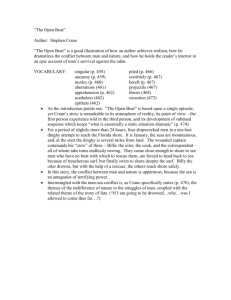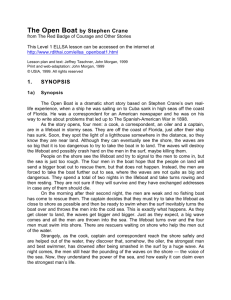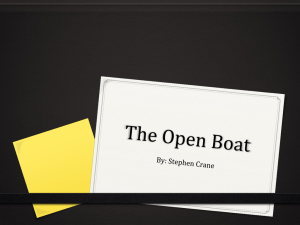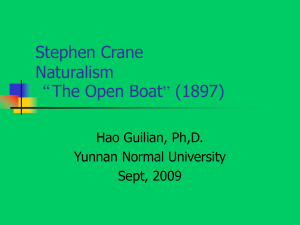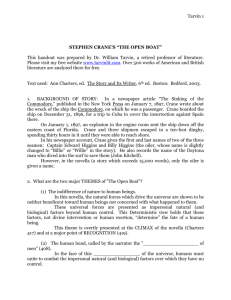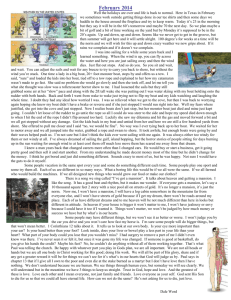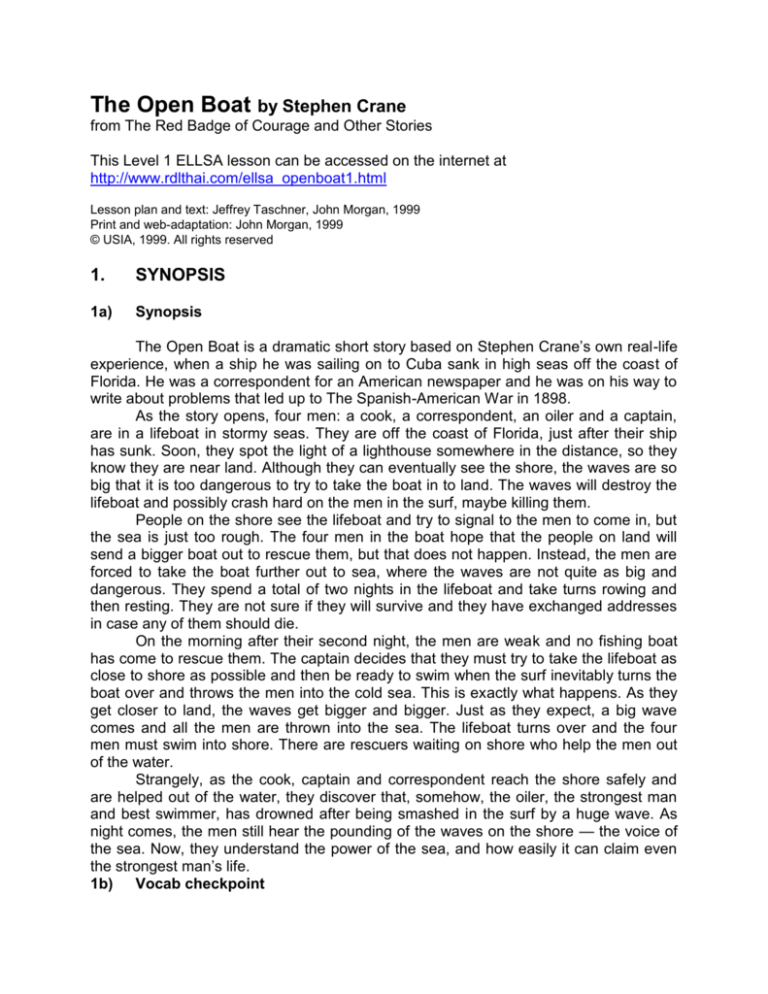
The Open Boat by Stephen Crane
from The Red Badge of Courage and Other Stories
This Level 1 ELLSA lesson can be accessed on the internet at
http://www.rdlthai.com/ellsa_openboat1.html
Lesson plan and text: Jeffrey Taschner, John Morgan, 1999
Print and web-adaptation: John Morgan, 1999
© USIA, 1999. All rights reserved
1.
SYNOPSIS
1a)
Synopsis
The Open Boat is a dramatic short story based on Stephen Crane’s own real-life
experience, when a ship he was sailing on to Cuba sank in high seas off the coast of
Florida. He was a correspondent for an American newspaper and he was on his way to
write about problems that led up to The Spanish-American War in 1898.
As the story opens, four men: a cook, a correspondent, an oiler and a captain,
are in a lifeboat in stormy seas. They are off the coast of Florida, just after their ship
has sunk. Soon, they spot the light of a lighthouse somewhere in the distance, so they
know they are near land. Although they can eventually see the shore, the waves are so
big that it is too dangerous to try to take the boat in to land. The waves will destroy the
lifeboat and possibly crash hard on the men in the surf, maybe killing them.
People on the shore see the lifeboat and try to signal to the men to come in, but
the sea is just too rough. The four men in the boat hope that the people on land will
send a bigger boat out to rescue them, but that does not happen. Instead, the men are
forced to take the boat further out to sea, where the waves are not quite as big and
dangerous. They spend a total of two nights in the lifeboat and take turns rowing and
then resting. They are not sure if they will survive and they have exchanged addresses
in case any of them should die.
On the morning after their second night, the men are weak and no fishing boat
has come to rescue them. The captain decides that they must try to take the lifeboat as
close to shore as possible and then be ready to swim when the surf inevitably turns the
boat over and throws the men into the cold sea. This is exactly what happens. As they
get closer to land, the waves get bigger and bigger. Just as they expect, a big wave
comes and all the men are thrown into the sea. The lifeboat turns over and the four
men must swim into shore. There are rescuers waiting on shore who help the men out
of the water.
Strangely, as the cook, captain and correspondent reach the shore safely and
are helped out of the water, they discover that, somehow, the oiler, the strongest man
and best swimmer, has drowned after being smashed in the surf by a huge wave. As
night comes, the men still hear the pounding of the waves on the shore — the voice of
the sea. Now, they understand the power of the sea, and how easily it can claim even
the strongest man’s life.
1b) Vocab checkpoint
• dramatic (adjective) When something is dramatic it is characterized by strong
feelings, emotions or adverse physical conditions (as in the meaning used here). It is
often used to describe a written style or method of acting (compare with drama, a noun,
which means play acting). Also, drama can be used to describe real events, and is
often heard in news reports.
• high seas (noun) High seas is a term used to describe rough, open sea where the
coast may be at a long distance or not visible at all. It may also be used to describe sea
in independent waters (not covered by the law of any particular country).
• oiler (noun) An oiler is an engine room worker on a ship whose job is to keep
mechanical parts oiled so they do not go rusty at sea.
• crash (verb) The most common meaning of crash is associated with the collision of
cars. Crash may also be used with the action of waves breaking on the shore, or on
something like a boat, swimmer or other object in the sea.
• signal (verb) To signal is to indicate using hands, a flag, a fire, lights or flares, etc.,
with the intention of seeking help from somebody else. A signal as a noun is a physical
symbol intended to warn or indicate something to people (e.g. traffic lights may be
called traffic signals).
• inevitably (adverb) If something is inevitable it means it will definitely happen, no
matter what action is taken to prevent it from happening.
• smashed (verb) Smashed is another way of saying broken. In this case it is used
figuratively to describe how the strongest of the men was beaten by the sea.
• huge (adjective) Huge means very large. Common synonyms of huge include
enormous, massive and gigantic.
• pounding (noun) The pounding of the waves describes the constant action and noise
of waves breaking against the shore or against the boat. To pound is to beat or hit
something constantly.
• claim (verb) To claim in this example, is to take. When a person claims something,
they make a statement to say it is their own (as with lost property at a police station). In
this case the sea claims the strongest man's life.
2)
PRE-STORY
2a)
Seven Scenes What is the most famous ship to ever sink at sea? What
happened? Have you seen the movie? Try to retell the story as just seven
important scenes or events from the movie. Work with a friend and use just one
sentence for each event.
1)
_______________________________________________________
2)
_______________________________________________________
3)
_______________________________________________________
4)
_______________________________________________________
5)
_______________________________________________________
6)
_______________________________________________________
7)
_______________________________________________________
Compare your Seven Scenes with other people and discuss the story.
Have you ever had, or witnessed an accident in a boat? If not an accident, think
about a frightening (or exciting) experience. What happened? Share your story
or write a short description for another group, who can plan some questions to
interview you about the event.
2b)
Analyzing a story's plot: Freytag's Pyramid
Sometimes life is not simple. Stories are not always easy to understand, either.
Gustav Freytag was a Nineteenth Century German novelist who saw common
patterns in the plots of stories and novels and developed a diagram to analyze
hem. He diagrammed a story's plot using a pyramid like the one shown here:
Break Down the Pyramid
Not every story you read can be diagrammed perfectly according to Freytag's
Pyramid, but many can. Before we look at an example with Titanic, lets try to
simplify Freytag's Pyramid by breaking it down into just three parts: beginning,
middle and end.
• Which parts of Freytag's Pyramid would form the beginning of a story?
• Which parts would make up the middle?
• Which parts would make up the end?
The Stages of Freytag's Pyramid
1.
Exposition: setting the scene. The writer introduces the characters
and setting, providing description and background.
2.
Inciting Incident: something happens to begin the action. A single
event usually signals the beginning of the main conflict. The inciting
incident is sometimes called 'the complication'.
3.
Rising Action: the story builds and gets more exciting.
4.
Climax: the moment of greatest tension in a story. This is often the most
exciting event. It is the event that the rising action builds up to and that
the falling action follows.
5.
Falling Action: events happen as a result of the climax and we know
that the story will soon end.
6.
Resolution: the character solves the main problem/conflict or someone
solves it for him or her.
7.
Dénouement: (a French term, pronounced: day-noo-moh) the ending.
At this point, any remaining secrets, questions or mysteries which remain
after the resolution are solved by the characters or explained by the
author. Sometimes the author leaves us to think about the THEME or
future possibilities for the characters. You can think of the dénouement
as the opposite of the exposition: instead of getting ready to tell us the
story by introducing the setting and characters, the author is getting ready
to end it with a final explanation of what actually happened and how the
characters think or feel about it. This can be the most difficult part of the
plot to identify, as it is often very closely tied to the resolution.
2c)
Titanic Plot Pyramid
To help you understand the definitions above, try to apply each step in Freytag's
Pyramid to the seven scenes you wrote down earlier. How well do they fit? Analyze with
a partner. Next, copy Freytag's Pyramid on a piece of paper and label each point on
the pyramid with these terms:
• Exposition
• Inciting Incident
• Rising Action
• Climax
• Falling Action
• Resolution
• Dénouement
Here is one teacher's analysis of the seven most important moments in Titanic.
Write each event above or below the point that it matches on Freytag's Pyramid. The
order should be the same as it occurred in the film.
•
•
•
•
•
•
•
Jack, Rose and the other passengers wait for lifeboats.
Jack stops Rose from committing suicide.
The Titanic splits in two and sinks.
Elderly Rose drops the necklace into the sea and visualizes Jack as she
dies peacefully.
The Titanic prepares to leave England for America with Jack and Rose
onboard.
Rose is rescued and gives her name as Rose Dawson. As a result, Cal
never finds her again.
Rose's mother, her fiancé, Cal, and Cal's bodyguard try to keep Jack
away from Rose as the two begin to fall in love. The ship hits an iceberg.
Check your answers with the answer key at the end of this lesson and discuss
Freytag's terms and definitions again as they relate to the plot of Titanic.
3.
IN-STORY
3a)
The Open Boat is based on Stephen Crane's own real-life experience, when
a ship he was sailing on to Cuba sank in high seas off the coast of Florida. He
was a correspondent for an American newspaper and he was on his way to
write about problems that led up to The Spanish-American War in 1898. How
many men are in the lifeboat when the story opens? Who are they? How do you
think they got there?
Can you remember which character says each of the following lines from the
story?
1. I wish we had a sail.
___________________
2. They'll see us before long and come out after us.
___________________
3. We'll overturn.
___________________
4. A little more north, sir.
___________________
5. Shall I take her to sea again captain?
___________________
6. Billie, would you row for awhile?
___________________
7. Come to the boat! Come to the boat.
___________________
8. Thanks old man.
9. What's that?
___________________
___________________
These quotes occur in the same order in the story as they do above. Try to use
the quotes above to remember the important events of a story and tell with a
friend. If you are in a class, different pairs can take turns retelling the story.
3b)
Following the plot
Number these events from 1-12 in the order in which they occurred in the story.
• ____ The captain saw the lighthouse on Mosquito Inlet.
• ____ The man on the shore saved the correspondent.
• ____ The men exchanged addresses.
• ____ The captain's ship sank.
• ____ The lifeboat sank.
• ____ The captain saw the lighthouse on Mosquito Inlet.
• ____ The correspondent saw that the oiler had drowned.
• ____ A man on the shore waved his coat at the men in the boat.
• ____ The second morning arrived.
• ____ The first morning arrived.
• ____ People come with blankets and coffee.
• ____ The captain gave his coat to the cook and correspondent to make a sail.
4.
EXERCISES
4a)
Applying Freytag's Pyramid to The Open Boat.
Look at the blank Plot Pyramid and label each of Freytag's seven steps from
memory. Next, re-order the events below from The Open Boat by copying the
corresponding sentence below each term on the pyramid.
•
•
•
•
•
•
•
4b)
The men jump off the boat into the water as the boat overturns.
4 men are in a lifeboat after a shipwreck.
The correspondent, cook and captain are rescued, but realize that the
oiler has drowned.
As the dead oiler is carried onto land, the other three men finally
understand the power of the sea and how lucky they are to be alive.
The captain sees the lighthouse.
The men try to row the boat to the shore.
The men swim to shore.
Freytag's Pyramid: review and extension
Draw Plot Pyramids like the ones you did for Titanic and The Open Boat for the
other stories you have already worked with in ELLSA.
Use single sentences to describe the key event/scene for each step in the plot.
Display them in class and discuss differences and similarities. Be prepared to
defend your choices.
5)
FOLLOW-UP
Life Raft
1.
You are traveling by passenger ferry to a resort island in the middle of the
Pacific Ocean. Suddenly a storm hits and the sea gets very rough. The
ferry starts to sink quickly. You and your friends find a very small life raft.
As the ferry sinks you must decide what you can take with you into the life
raft and what you must leave behind. You only have room for 5 things
from the list below. Which five will you take?
• a portable stereo with AM/FM radio
_____
_____
• a white bed sheet
_____
_____
• a small mirror
_____
_____
• a bottle of whiskey
_____
_____
• a box of canned tuna
_____
_____
• a large bag of chocolate candy
_____
_____
• a map of the Pacific Ocean
_____
_____
• a mosquito net
_____
_____
• a fishing kit
_____
_____
• 5 meters of nylon rope
_____
_____
• a life jacket
_____
_____
• a 5 liter bottle of water
_____
_____
Consider these items carefully and think of ways to justify your choices.
Why have you decided to take the five items that you have selected?
Find out what other people would choose to take.
2.
Ranking
Rank the objects above from 1-12, based on their importance for your
survival and rescue. 1 is the most useful and 12 is the least useful. Check
your answers with the answer key below.
ANSWER KEY
2c)
Titanic Plot Pyramid: answer key
1.
2.
3.
4.
5.
6.
7.
3a)
Exposition
The Titanic prepares to leave England for America with Jack and Rose
on-board.
Inciting Incident
Jack stops Rose from committing suicide.
Rising Action
Rose's mother, her fiancé, Cal, and Cal's bodyguard try to keep Jack
away from Rose as the two begin to fall in love. The ship hits an iceberg.
Climax
The Titanic splits in two and sinks.
Falling Action
Jack, Rose and the other passengers wait for lifeboats.
Resolution
Rose is rescued and gives her name as Rose Dawson. As a result, Cal
never finds her again.
Dénouement
Elderly Rose drops the necklace into the sea and visualizes Jack as she
dies peacefully.
Lines from the story: answer key
1. I wish we had a sail. The captain, pg 4, pa 2
2. They'll see us before long and come out after us. The cook, pg 4, pa 6
3. We'll overturn. Everybody, pg 5, pa 7
4. A little more north, sir. The oiler, pg 5, pa 2
5. Shall I take her to sea again captain? The oiler, pg 6, pa 5
6. Billie, would you row for awhile? The correspondent, pg 11, pa 3
7. Come to the boat! Come to the boat. The captain, pg 14, pa 9
8. Thanks old man. The correspondent, pg 15, pa 2
9. What's that? the old man/rescuer, pg 16, pa 2
3b)
Following the plot: answer key
1.
2.
3.
4.
5.
6.
7.
8.
9.
10.
11.
12.
The ship sank.
The first morning arrived.
The captain saw the lighthouse on Mosquito Inlet.
The correspondent saw the lighthouse.
The captain gave his coat to the cook and correspondent to make a sail.
The men exchange addresses.
A man on the shore waved his coat at the men in the boat.
The second morning arrived.
The lifeboat sank.
The man on the shore saved the correspondent.
The correspondent saw that the oiler had drowned.
People come with blankets and coffee.
4a)
5)
Applying Freytag's Pyramid to The Open Boat: answers
1.
2.
3.
4.
Exposition
Inciting Incident
Rising Action
Climax
5.
6.
Falling Action
Resolution
7.
Dénouement
4 men are in a lifeboat after a shipwreck.
The captain sees the lighthouse.
The men try to row the boat to the shore.
The men jump off the boat into the water as
the boat overturns.
The men swim to shore.
The correspondent, cook and captain are
rescued, but realize that the oiler has
drowned.
As the dead oiler is carried onto land, the
other three men finally understand the power
of the sea and how lucky they are to be alive.
Life Raft: suggested answer key
The following rating is based on the professional opinions of officers from The
US Merchant Marine.
1.
2.
3.
4.
5.
6.
7.
8.
9.
10.
11.
12.
Mirror for signaling rescue boats or planes.
Five liter bottle of water for drinking.
One case of canned tuna to eat.
White bed sheet to collect rain water, provide shelter, maybe as a signal
flag.
Candy as a reserve food supply.
Fishing kit ranked lower than candy because 'a bird in the hand is worth
two in the bush'. You can't be sure that you'll catch any fish.
Nylon rope to tie things/people together to keep them from falling out of
the raft.
Life jacket as a life preserver in case of a man-overboard situation.
Whiskey as an antiseptic for injuries. It will cause dehydration if drunk,
however.
Portable stereo is of little use as it cannot transmit (send) messages.
Mosquito netting there are no mosquitoes in the middle of the ocean and
it is not really useful as a fishing net.
Map is worthless without navigational equipment.
(Adapted from Pfeiffer (1987) and Schummacher & Schummacher (1992).

